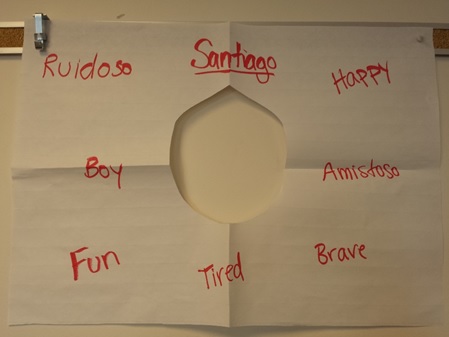|
After engaging in various conversations with many colleagues in
the English as a second language (ESL) industry for several years in
Toronto, I have learned that issues of social justice are minimally
discussed in the classroom as a pedagogical tool. Many have experienced
that in deed social justice work has been done in classes, but that
sometimes we feel we should teach these issues more explicitly. I feel
that sometimes educators forget to address issues of social justice
because we focus too much on the linguistic aspects of teaching
(grammar, pronunciation, writing, etc.) and not on the social side of
education.
Many scholars agree that social justice is a term complicated
to conceptualize. Though we may agree that teaching for or about social
justice is the right thing to do, conceptual clarity on the notion is
necessary. For the purposes of this article, I will use the definition
given by Nieto and Bode (2008), who define social justice as a
philosophy, an approach, and actions that embody treating all people
with fairness, respect, dignity, and generosity. I believe we all do
some of this in our classrooms already; it is just that we are not aware
or do not always conceptualise the work within the frames of social
justice. In other words, we get up every day and go to our schools to
teach English, and we hope to create a learning environment that is just
for all in the class. For example, we all give equal opportunities for
students to participate in class, we prepare classes that are culturally
relevant, and we understand students’ cultural and linguistic
backgrounds.
Some ESL colleagues may argue that sometimes we teach critical
and challenging topics. Unfortunately, there has not been a systematic
way developed to address such topics because we are all busy and
sometimes we simply do not have time. To organize a way to implement
social justice work in our classes, I recommend using Picower’s (2012)
six elements of social justice curriculum design. For the purposes of
this article, I will only focus on the first element, which is called
“self-love and knowledge.” Under this theme, teachers look at
understanding the students, where they are from, and what their
linguistic and cultural backgrounds are. Students primarily learn from
culture, heritage, other languages, race, religion, and personal and
family stories. Students learn about themselves, their own identities,
and others. To promote this first element of social justice in the ESL
classroom, I present two simple classroom activities.
Activity 1: This Is Me
Level A1 CEFR / CBL Level 3/4
Social justice work starts from the beginning of the academic
year. Recognizing and validating students’ identities and background is a
good way to welcome students in the classroom. “This Is Me” is a
project that is simple but meaningful for students. Students use butcher
paper, make a large hole in the middle, and write some words that best
describe them. Students can use English or words from their home
language. Afterward, they put their head in the hole and present in
front of the class.
Example:
“My name is Santiago. I am a happy person, a bit ruidoso [noisy]. I am brave and amistoso [friendly]. I am also a boy who likes to
have a lot of fun. But, sometimes I feel tired.”

Activity 2: Identity Portraits
Level A1/A2 CEFR/CBL Level 4/5
Students are “asked to use any medium (e.g., words, colours,
pictures, cartoons, photographs, etc.) to represent the different
elements of their sociocultural identities (such as language, religion,
ethnicity, roles they played in society, etc.)” (Herath, 2015, p. 141).
Students can draw, for example, a flag on the chest of a drawn
silhouette to symbolise that their home is their heart and write the
word friends in the head to mean that friends are
always on their mind. Students can use this idea to make multimodal
identity portraits, posters, videos, and spoken word poetry and share it
with their friends, family, and the community.

Although I have used only one of Picower’s (2012) elements to
exemplify how an ESL teacher can engage his or her students with more
culturally relevant themes, I encourage teachers to keep learning and
engaging in conversations about societal social inequalities. Teachers
and students have experienced these inequalities, and we must provide
the space to discuss them openly and carefully. We may find challenges
and dissonance along the way, but I can assure you that the rewards of
working together with students will eventually come. We want to foster
critical students who use language to talk about social justice issues,
students who make personal and community connections, and students who
become more aware of the context that surrounds them—but, overall,
students who will become better citizens to improve the quality of the
communities in which they live. At the end of the day, social justice in
ESL lies in our practice as teachers and the motivation and inspiration
we provide to our students.
References
Herath, S. (2015). Teachers as transformative intellectuals in
post-conflict reconciliation: A study of Sri Lankan language teachers'
identities, experiences and perceptions (Unpublished doctoral
dissertation). University of Toronto, Toronto, Canada.
Nieto, S., & Bode, P. (2008). Affirming
diversity: The sociopolitical context of
multicultural education (5th ed.). Boston, MA: Allyn &
Bacon.
Picower, B. (2012). Using their words: Six elements of social
justice curriculum design for the elementary classroom. International Journal of Multicultural Education.
14(1). 1–17.
Yecid’s main research interests draw from critical
ethnographic approaches in language teaching and learning. He explores
how social justice juxtaposes with concepts of culture, race,
linguistics, human rights, and gender equality in different language
education programs (e.g., TESOL, EFL/ESL) in international contexts. For
more information about social justice-inspired lessons for ESL visit andjustice4all.ca. |

